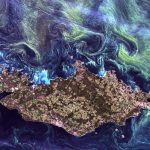 March 5, 2020 9:52 am
Published by Climate Extremes
March 5, 2020 9:52 am
Published by Climate Extremes
In recognition of International Women’s Day, the chief investigators at the ARC Centre of Excellence for Climate Extremes (CLEX) have signed up to the Male Champions of Change Panel Pledge. This commits the chief investigators to bring gender balance to every forum
 February 27, 2020 3:49 pm
Published by Climate Extremes
February 27, 2020 3:49 pm
Published by Climate Extremes
Kim Reid had a very fruitful conference at AMOS 2020, but she also had two panic attacks. Here she talks about living with these attacks and how someone in a similar situation can navigate and still get plenty of benefits from crowded conferences.
 February 25, 2020 3:12 pm
Published by Climate Extremes
February 25, 2020 3:12 pm
Published by Climate Extremes
This paper is a review article that stemmed from a debate within the Southern Ocean community. The paper explains how “fronts”, sharp boundaries between water masses, are defined, and what their effects might be on the biology of the Southern Ocean.
 February 25, 2020 7:34 am
Published by Climate Extremes
February 25, 2020 7:34 am
Published by Climate Extremes
In this study of drought and rainfall over the Murray Darling Basin, CLEX authors find that the length of time between La Niñas and negative-IODs is an important indicator of the likelihood of drought for this region.
 February 13, 2020 12:09 pm
Published by Climate Extremes
February 13, 2020 12:09 pm
Published by Climate Extremes
Using a novel methodology applied to CMIP5 projections CLEX researchers found that the local temperatures experienced by 90% of people would be substantially higher in a transient (still warming) climate than an equilibrium climate where the temperatures have plateaued, for the same global temperature.
 February 12, 2020 2:19 pm
Published by Climate Extremes
February 12, 2020 2:19 pm
Published by Climate Extremes
This study looks at data-sharing issues and outlines the history of the rationale and use of indices, the types of indices that are frequently used and the advantages and pitfalls in analysing them.
 February 12, 2020 1:38 pm
Published by Climate Extremes
February 12, 2020 1:38 pm
Published by Climate Extremes
Research by CLEX scientists and colleagues re-examines some of the basic assumptions and interpretations in the theory. In particular, they show the SAM cannot be interpreted as a descriptor of mid-latitude variability and it has little imprint on the weather of the storm track.
 February 12, 2020 12:06 pm
Published by Climate Extremes
February 12, 2020 12:06 pm
Published by Climate Extremes
CLEX researchers evaluate the performance of satellite chlorophyll observations in the tropical Pacific Ocean and suggest algorithm improvements.
 February 12, 2020 11:20 am
Published by Climate Extremes
February 12, 2020 11:20 am
Published by Climate Extremes
This work describes a new cross-scale modelling framework for urban environments and applies it to calculate how electricity and gas demand will change under future climate change and air conditioner (AC) ownership scenarios.
 February 11, 2020 4:25 pm
Published by Climate Extremes
February 11, 2020 4:25 pm
Published by Climate Extremes
In this work, CLEX researchers compared the performance of three ocean simulations – with low, medium and high resolutions – when representing marine heatwaves.










